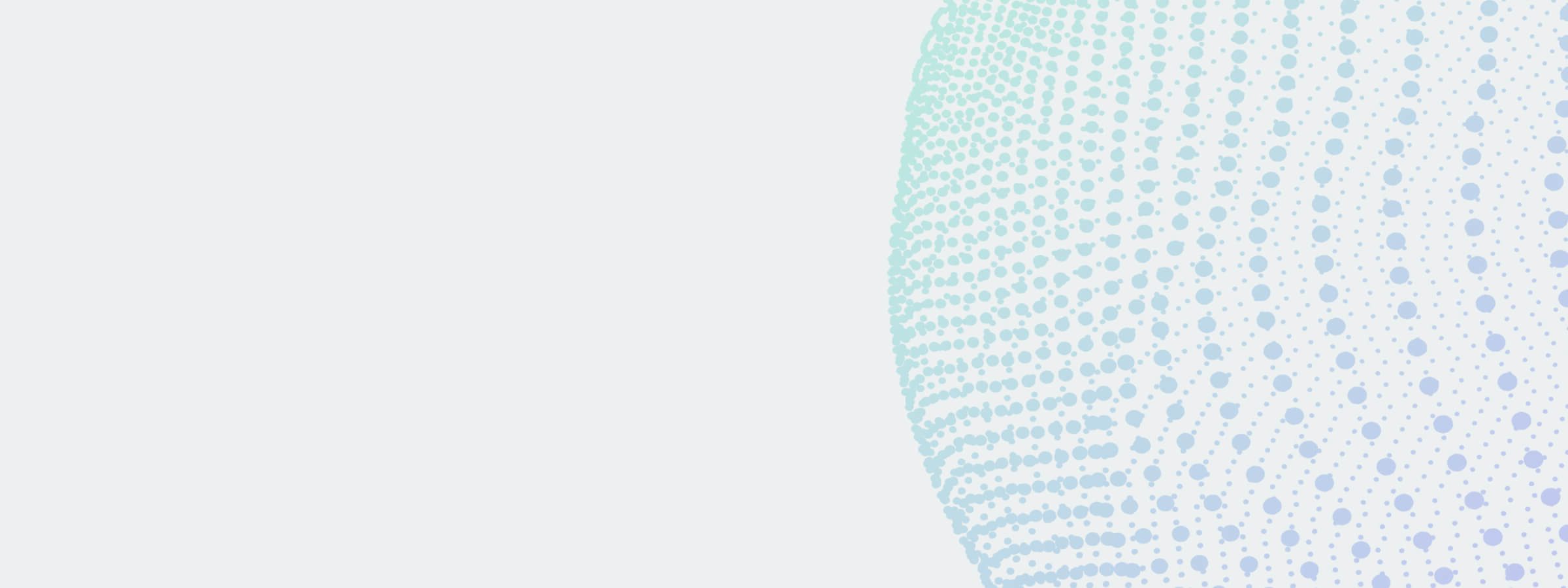
In recent years neural networks have played a major role in advances in the field of artificial intelligence (AI). This has been reflected in growth in patenting activity related to neural networks not only at the European patent office but also at other patent offices around the world.
Worldwide patenting activity related to “neural networks”
An estimate of worldwide patenting activity can be based the number of new families of patent applications appearing each year across the one hundred or so countries covered by the EPO’s new Espacenet database[i]. An Espacenet family of applications (which may include granted patents) is made up of one or more patent publications that relate to the same invention/technical development. Generally, this means that all members of the family claim the same priority. The family may include publications in different countries and/or different publications in the same country (e.g. publications of the application and then of the granted patent). A new Espacenet family appears with the earliest publication of any member of the family (by any patent office) as noted in the new Espacenet database.
A key to assessing patenting activity related to neural networks is the International Patent Classification (IPC)[ii]. Since 2006, the main IPC classifications related to inventions/technical developments in the field of neural networks have been G06N 3/02 together with its hierarchy of subordinate classifications[iii].
Espacenet families with members relating to neural network inventions/technical developments can be identified in that they have received a G06N 3/02 classification (i.e. at least one member of the family has received such a classification either as lead or further classification)[iv]. The changing numbers of these families provides a picture of patenting activity related to neural networks.
Espacenet “neural network” patent application families
Across the countries covered by Espacenet, from 2012 to 2022 (the number of families noted for 2022 should be regarded as preliminary; it can be expected to increase) there has been an astonishing 150-fold growth in the numbers of new neural network patent application families appearing year by year: Over 10-fold growth from 2012 to 2017 followed by 15-fold growth from 2017 to 2022.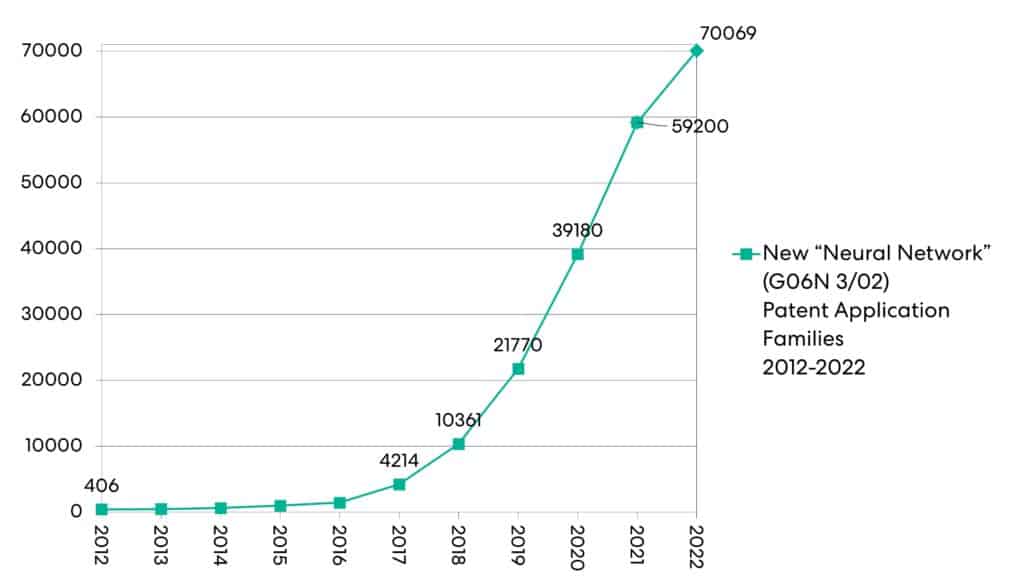
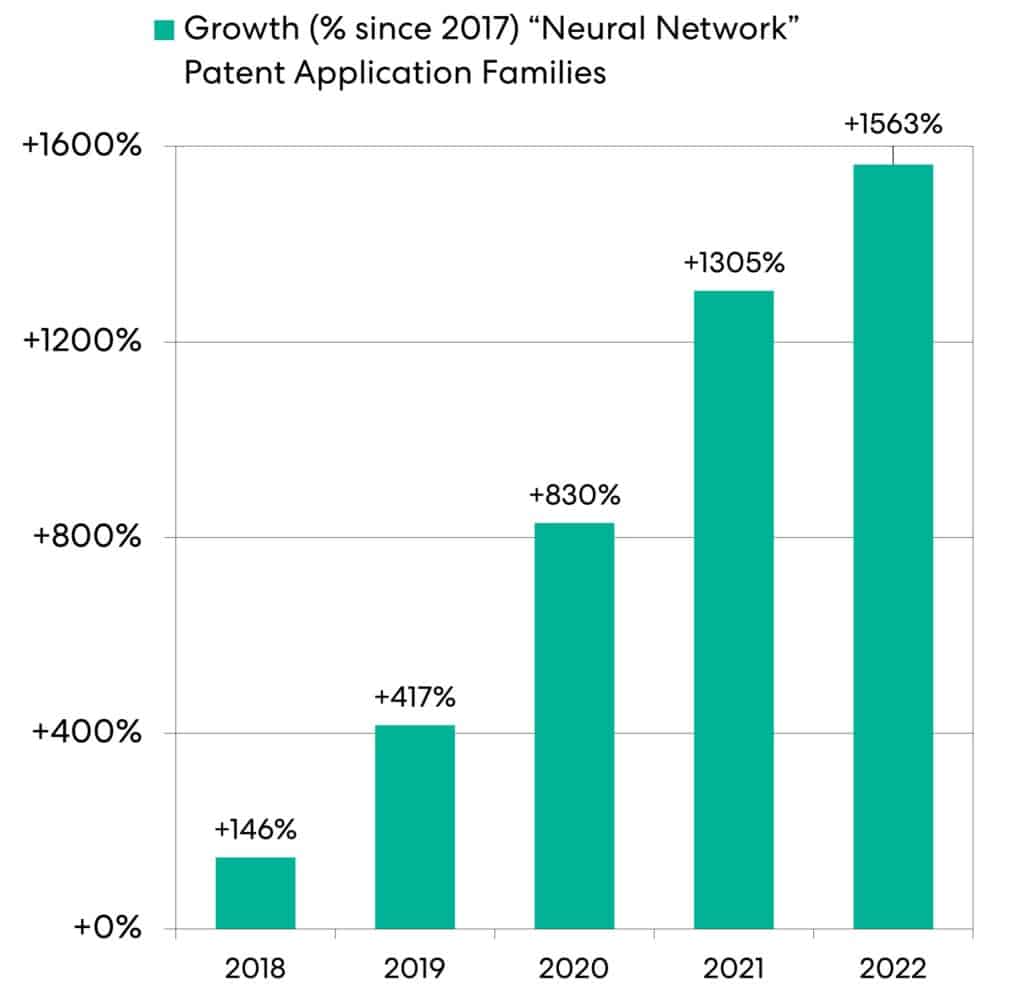
Geographical origin of “neural network” patent application families
The countries of origin of inventions/developments with which neural network patent application families are concerned may be of interest. Priority countries of Espacenet families are generally an indicator of origin.
According to Espacenet, China has increasingly been the priority country of the majority of neural network patent application families, rising to 80% of neural network families in 2021. As an aside, Chinese-originating applications do not dominate other related classifications, such as the Machine Learning classification GO6N 20, to such a great extent, and this could be the result, for example, of differing classification techniques between patent offices, or an actual trend, or some mixture of the two. In any case, from 2017 to 2021 neural network families having China as priority country grew sixteen-fold. However, growth was not confined to families with China as priority country: neural network patent application families with priority countries other than China also experienced strong growth: nearly nine-fold growth from 2017 to 2021. (Information for 2022 should be regarded as preliminary).
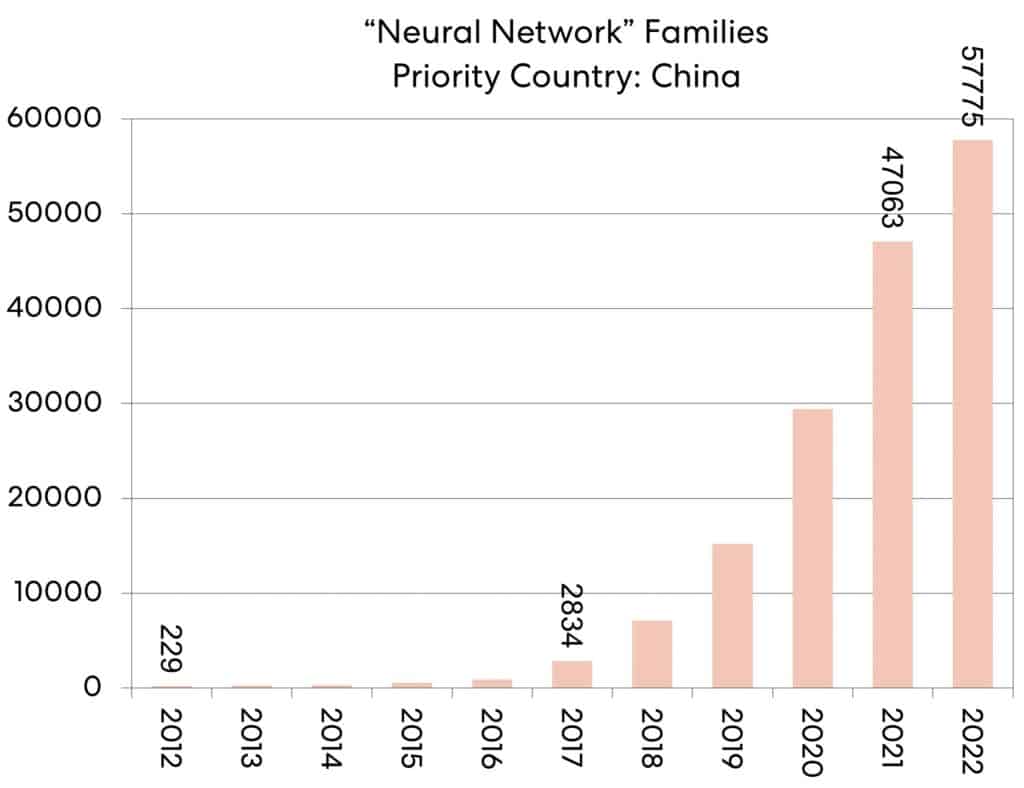
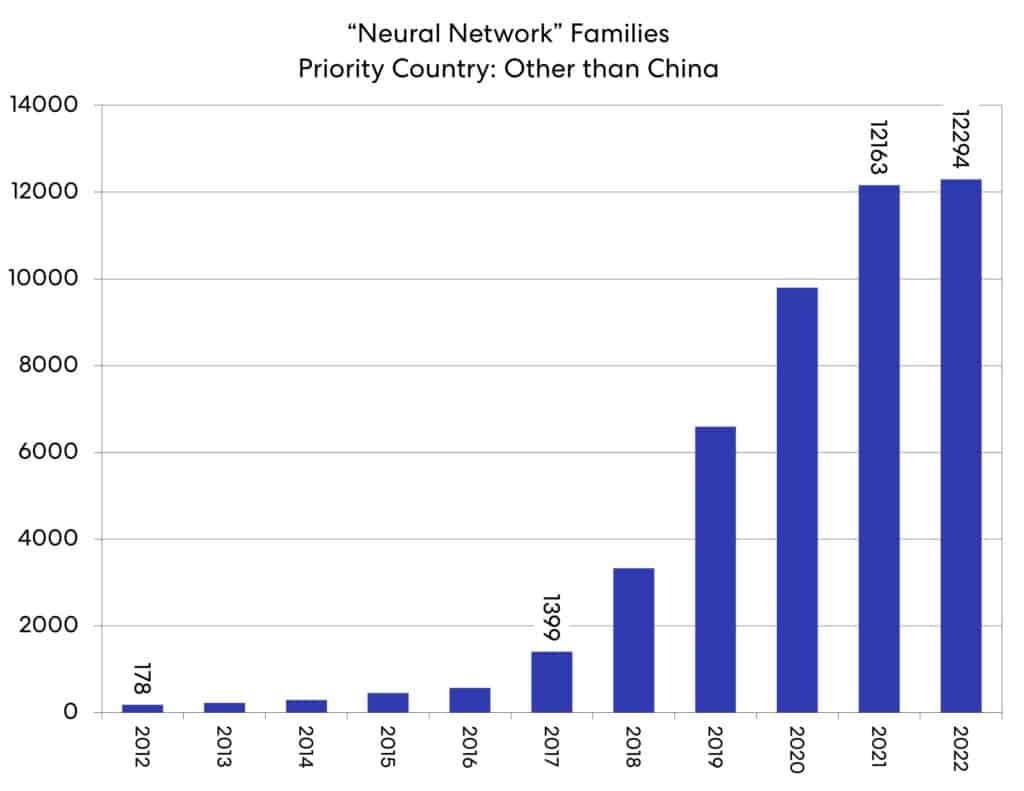
After China, USA, Korea and Japan are frequently the countries of origin of the inventions/developments related to neural networks. USA and Korea have been most active, with Korea showing growth in neural network families comparable to that of China, although from a much lower level.

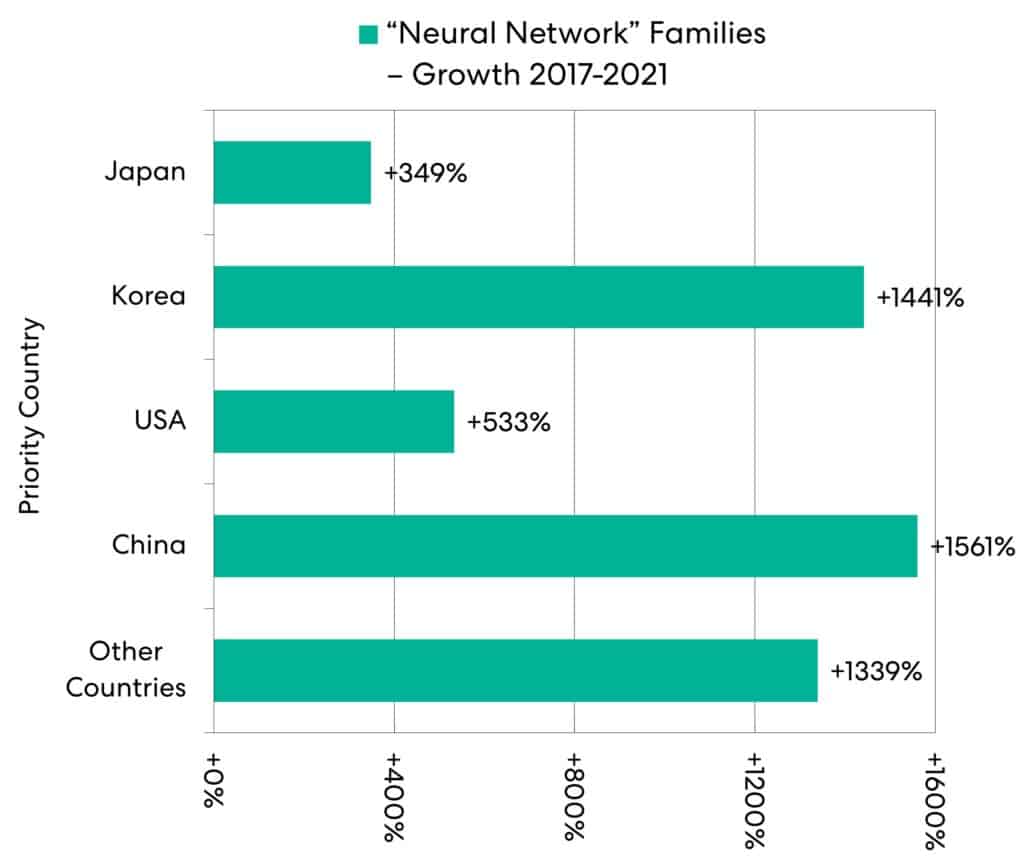
A notable feature of neural network patent application families with China as priority country is that 90% or more of those families are “domestic”: they have only Chinese members, with no members in countries other than China – 10% or less of families with China as priority country are “international”, having at least one member in a country other than China. In contrast, over 50% of families with the US as priority country are “international”, around 30% of families with Korea as priority country are “international” and 70% or more of families with Japan as priority country are “international”.
Who files “neural network” patent application families
The companies and institutions recently active in the field of neural networks may be of interest. One indicator is the numbers of Espacenet patent application families associated with particular applicants. This can only be estimated since counting families depends e.g. on how families belonging to related but legally distinct companies are handled, how families belonging to joint applicants are counted and particularly how translations of names and variations in naming of applicants are handled. That said, the table below indicates the estimated top applicants in terms of their numbers of new neural network families appearing in 2022 so far. These top applicants accounted for just over 10% of all new neural network families in 2022. By far the majority of the applicants in the table are Chinese, many being universities.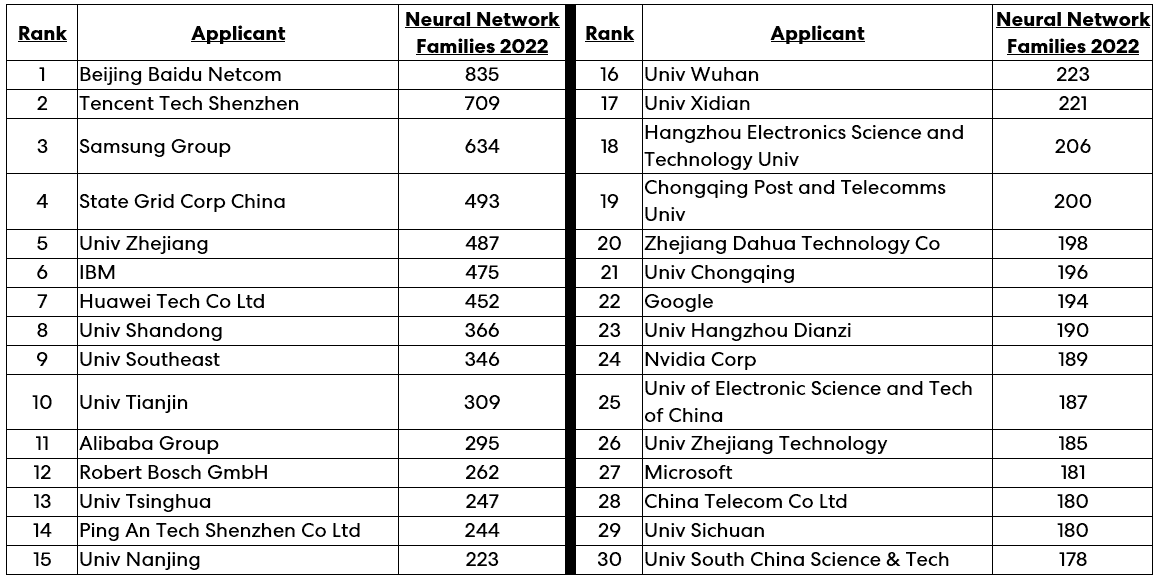
Neural networks – patenting activity at the European Patent Office
Based on information in the EPO’s “EP Bulletin Search” database, developments concerned with European patent (EP) applications related to neural networks can be followed, again using the main IPC classification G06N 3/02 (together with its hierarchy of subordinate classifications).[v]
“Neural network” EP applications published
Around 7000 neural network EP applications have so far been published. Very small numbers of neural network applications were published up to 2017. However, from 2017 to 2022 the numbers of neural network applications published each year increased 15-fold (the number of neural network applications published in 2022 should be regarded as preliminary; it can be expected to increase as information is finalised). In comparison, over the period 2017 to 2022 the total number of EP applications published each year rose by only 10%.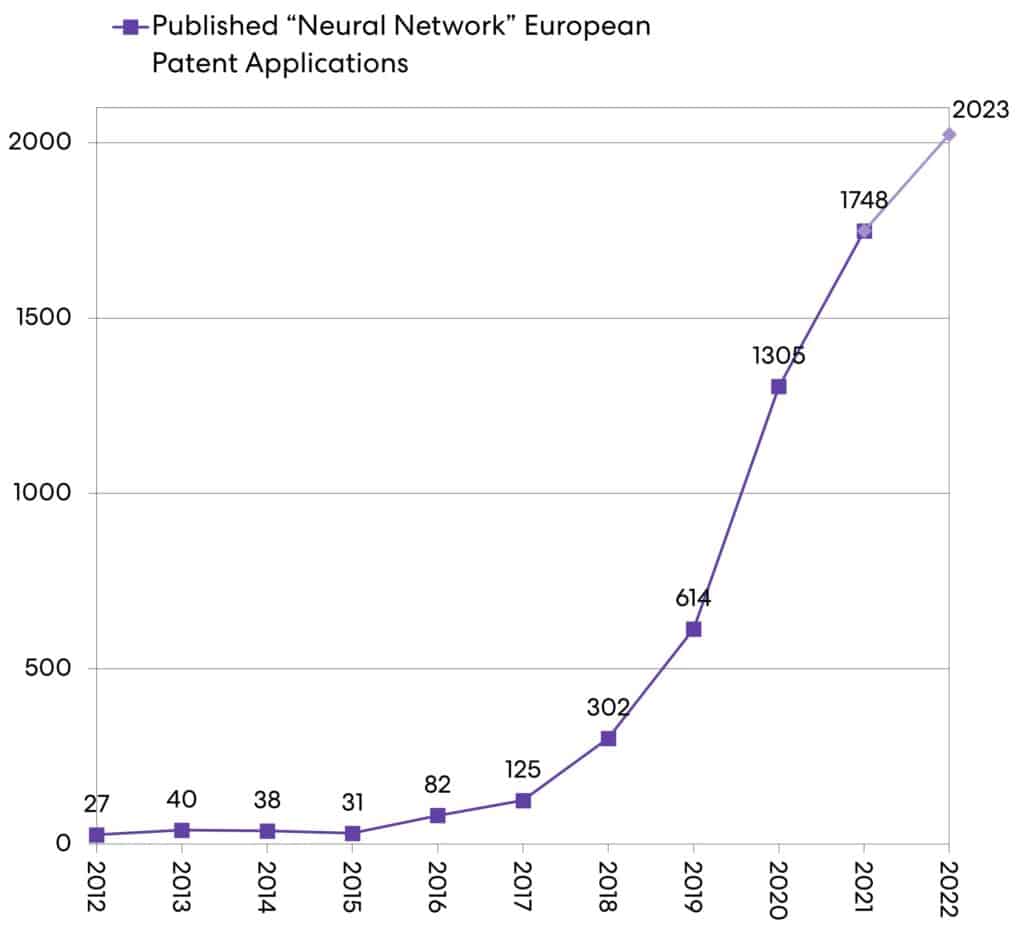
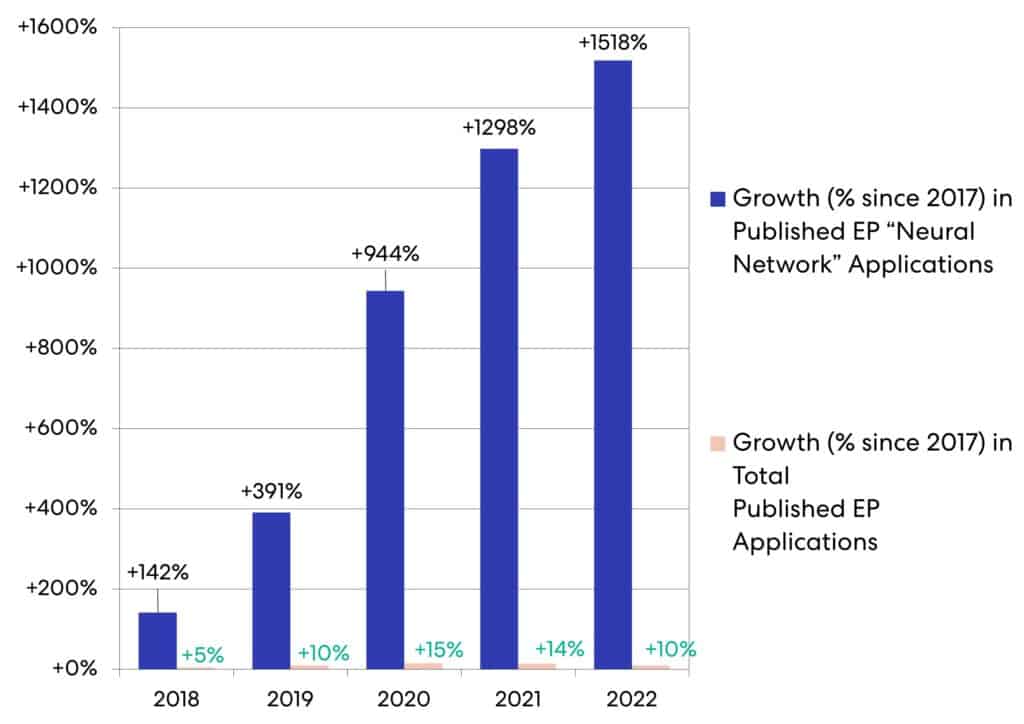
Who files “neural network” European Patent applications
The 2000 or so neural network European patent applications published in 2022 (for which information is so far available) belonged to around 600 different applicants. Around 5% of those applicants accounted for just over half of the 2000 published applications.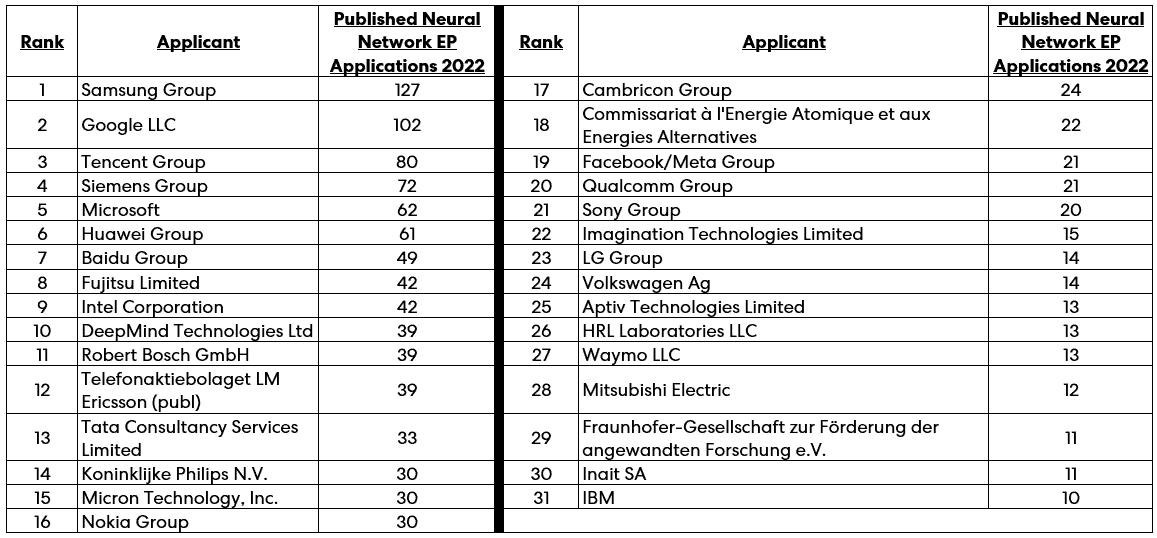
Outcomes of “neural network” EP applications
Of the 7000 or so published neural network EP applications around 2000 have so far been processed to a conclusion: patents have been granted or the applications have been refused, withdrawn or deemed withdrawn.[vi]
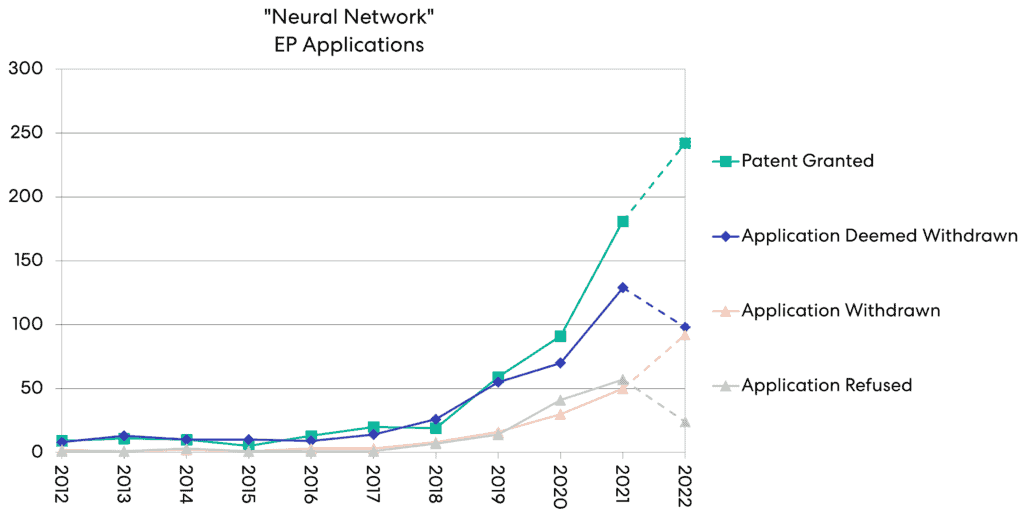
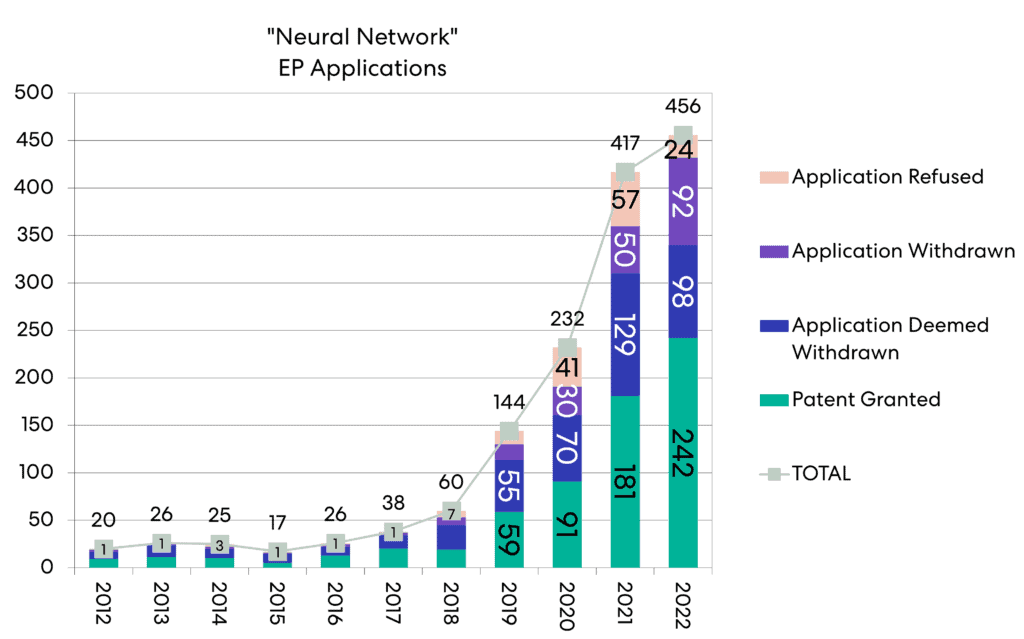 For the neural network applications processed to conclusions from 2012 to 2022, grant as patents was the most likely outcome but still less than half of all outcomes, and compared to all European applications in general, grant was significantly less likely outcome for neural network applications (45% for 2012 to 2022, compared to 62% for all European applications in general). Refusal was a more likely outcome for neural network applications than for all European applications in general (10% compared to 4% for all European applications in general).
For the neural network applications processed to conclusions from 2012 to 2022, grant as patents was the most likely outcome but still less than half of all outcomes, and compared to all European applications in general, grant was significantly less likely outcome for neural network applications (45% for 2012 to 2022, compared to 62% for all European applications in general). Refusal was a more likely outcome for neural network applications than for all European applications in general (10% compared to 4% for all European applications in general).

Although the statistics indicate that for neural network applications grant is in general a less likely outcome and refusal a more likely outcome for applications than for all European applications, outcomes do vary greatly for different applicants/patentees. For ten of the most active applicants/patentees over the period 2012 to 2022 the proportion of patents granted varied from 2% to 88% and the proportion of applications refused ranged from none to 25%. Different applicants/patentees also appear to have quite different policies regarding withdrawal of applications – two of the ten applicants did not positively withdraw any applications as opposed to allowing them to be deemed withdrawn. Other applicants have positively withdrawn good proportions of their applications (which may be as a result of a general policy, or a reaction to poor prospects for success).
We can speculate about the reasons for the variation in success rate, but at least some variation is likely to be attributable to the field in which the applicant is operating. In general, AI is deemed to be a mathematical method at the EPO, and the EPO recognises character (and thus patentability) of AI only in the two “dimensions” of specific technical implementation (motivated by consideration of internal functioning of computer) and technical application (application to a field which the EPO deems technical) – see EPO Guidelines for Examination G-II, 3.3 and G-II, 3.3.1. Some neural network inventions relate to the underlying low-level software or hardware, but many do not, and need to have application in a technical field explicitly or implicitly defined in the independent claim before they are deemed patentable at the EPO. 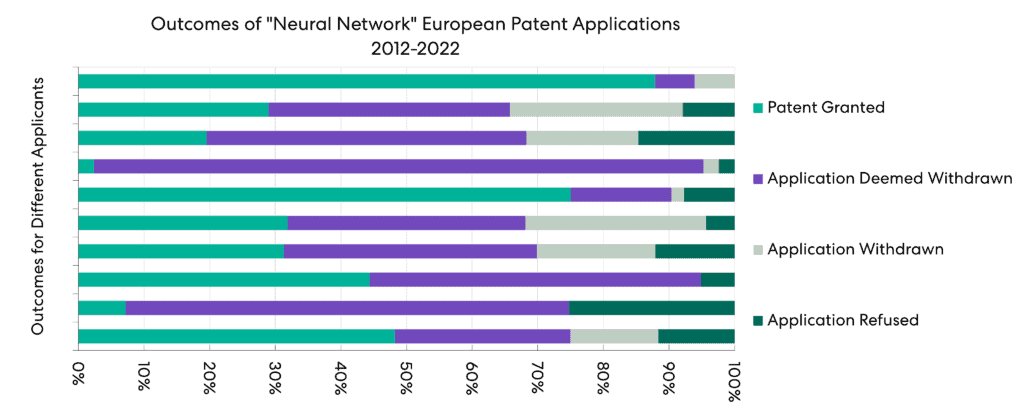
Oppositions to “neural network” EP patents
Up to the end of 2022, a total of about 900 neural network EP patents had been granted. At the end of 2022 the EPO’s opposition period (9 months from patent grant) had expired for just short of 700 of those patents. Neural networks fall within a general field of technology (IPC Section G, Physics) in which generally only around 1% of EP patents have been opposed [vii] and perhaps, on this basis, it might have been expected that a half dozen or so neural network patents would have been opposed. However, only one neural network patent has so far been opposed (EP0534221, granted in 1996).
Aspects of “neural network” technologies subject of EP patent applications
The 2000 European neural network patent applications published in the 2022 have lead classifications and, usually, further classifications along with the lead classifications. The 2000 lead classifications of the European patent applications are spread over more than 500 different individual classifications. The applications have a total of around 8000 classifications spread over about 1500 different individual classifications.
Over 3000 of the total 8000 classifications and over 800 of the lead classifications are directly concerned with aspects of neural network technologies. By a clear margin the most frequent of those technologies/classifications were G06N 3/04, which concerns architecture of neural networks, and G06N 3/08 which concerns learning methods for neural networks.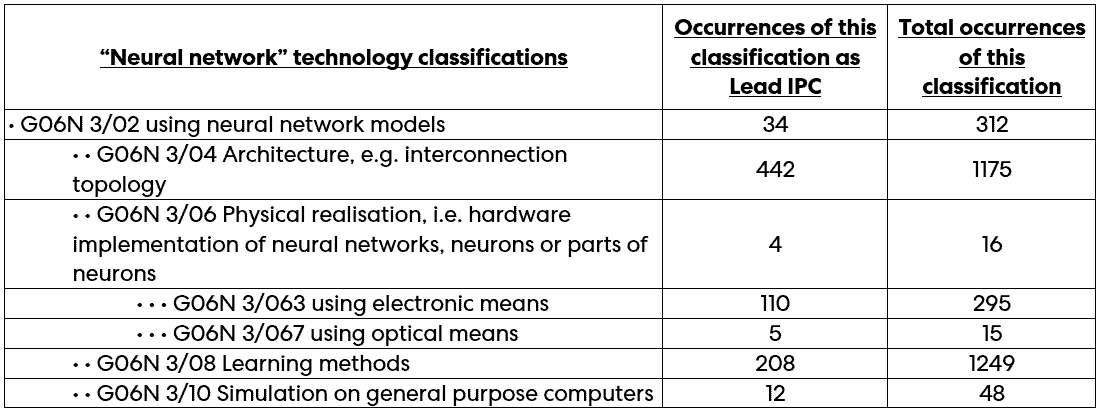
Uses of “neural networks”
Neural networks have found uses across many fields. Indicators of potential uses may be provided by IPC classifications applied to neural network EP applications, either as lead classification or as a further classifications, beyond the classifications directly concerned with aspects of neural network technologies.
The most common “use” classifications applied to the 2000 European patent applications published in 2022 relate to pattern recognition, machine learning in general and image analysis. Other potential uses relate to handling of natural language data, speech recognition, medical diagnosis, video recognition etc.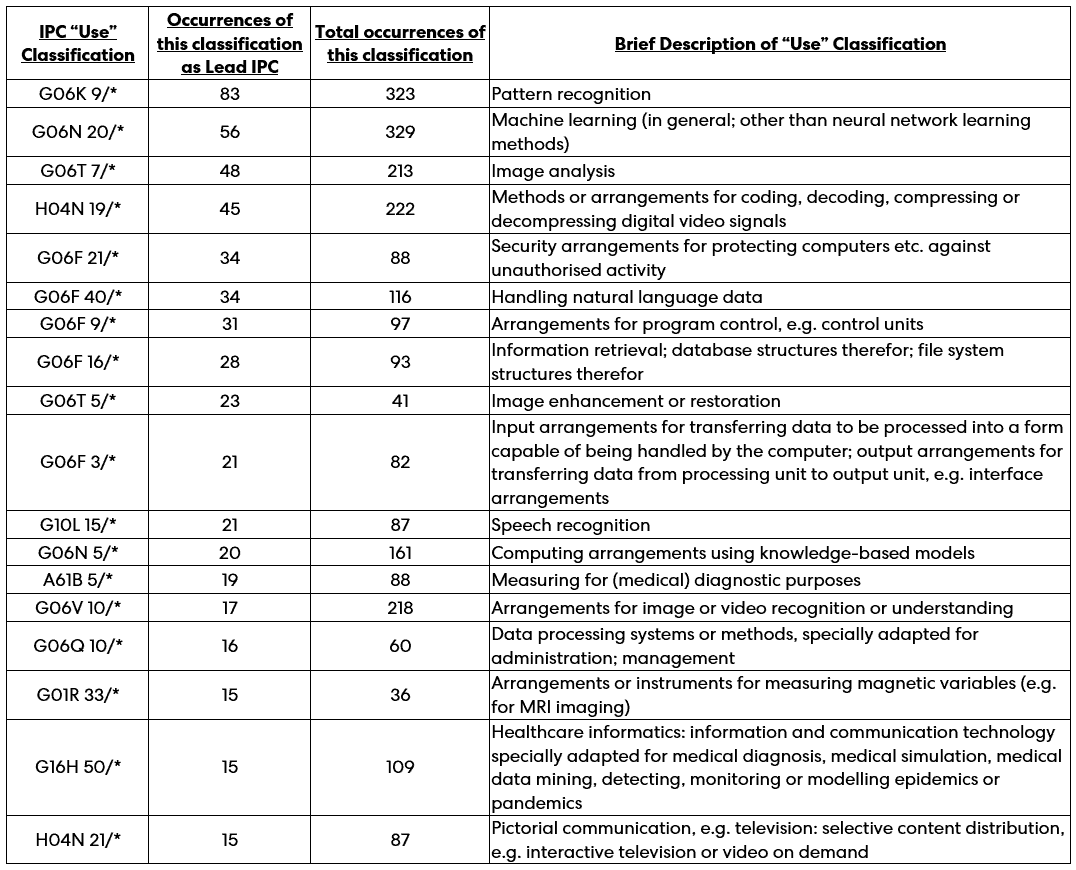
What does a “neural network” patent look like?
Finally, we set out below links to the first 25 neural network patents granted by the EPO in 2023, along with their prosecution history in the EP register, for those who would like to see an example of the kind of subject matter currently being granted at the EPO and objections raised along the way.
| First 25 “neural network” patents granted in 2023 | ||||
| Patent No. (Links to B1 Publication) | Grant Date | Application No. (Links to European Patent Register) | Applicant / Proprietor | Title |
| EP 3371807 B1 | 04-01-2023 | EP 16802210.1 | Google LLC | Generating target phoneme sequences from input speech sequences using partial conditioning |
| EP 3584573 B1 | 04-01-2023 | EP 17896482.1 | Nippon Telegraph and Telephone Corp | Abnormal sound detection training device and method and program therefor |
| EP 3599606 B1 | 04-01-2023 | EP 19188109.3 | Accenture Global Solutions Ltd | Machine learning for authenticating voice |
| EP 3738082 B1 | 11-01-2023 | EP 19715337.2 | Amazon Technologies, Inc. | Accelerated quantized multiply-and-add operations |
| EP 3857459 B1 | 11-01-2023 | EP 20765105.0 | Mitsubishi Electric Corporation | Method and system for training a dialogue response generation system |
| EP 3757896 B1 | 11-01-2023 | EP 19217269.0 | Cambricon Technologies Corp Ltd | Method and device for pre-processing data in a neural network |
| EP 3836435 B1 | 11-01-2023 | EP 19859240.4 | Huawei Technologies Co., Ltd. | Channel prediction method and related device |
| EP 3953765 B1 | 11-01-2023 | EP 20709599.3 | ASML Netherlands B.V. | Systems and methods for adjusting prediction models between facility locations |
| EP 3533681 B1 | 11-01-2023 | EP 19178149.1 | Apollo Intelligent Driving Technology (Beijing) Co., Ltd. | Method for detecting safety of driving behavior, apparatus and storage medium |
| EP 3353655 B1 | 11-01-2023 | EP 16798590.2 | Google LLC | Stream-based accelerator processing of computational graphs |
| EP 3639141 B1 | 11-01-2023 | EP 18730906.7 | Microsoft Technology Licensing, LLC | Machine learning for constrained mutation-based fuzz testing |
| EP 3567477 B1 | 18-01-2023 | EP 19171005.2 | Guangdong Oppo Mobile Telecommunications Corp., Ltd. | Method for preloading application, storage medium, and terminal |
| EP 3674967 B1 | 18-01-2023 | EP 18867060.8 | Huawei Technologies Co., Ltd. | Image signal processing method, apparatus and device |
| EP 3809220 B1 | 18-01-2023 | EP 19203001.3 | Honda Research Institute Europe GmbH | Method and system for semi-supervised deep anomaly detection for large-scale industrial monitoring systems based on time-series data utilizing digital twin simulation data |
| EP 3948850 B1 | 18-01-2023 | EP 20706847.9 | Mitsubishi Electric Corporation | System and method for end-to-end speech recognition with triggered attention |
| EP 3771999 B1 | 18-01-2023 | EP 20161994.7 | KunlunXin Technology (Beijing) Company Limited | Method and apparatus for extracting image data in parallel from multiple convolution windows |
| EP 3793447 B1 | 18-01-2023 | EP 19803070.2 | New York University/Yeda R&D Co. Ltd. | System and method for orientating capture of ultrasound images |
| EP 3460494 B1 | 25-01-2023 | EP 17193123.1 | Siemens Aktiengesellschaft | A method and apparatus for automatic detection of a fault type |
| EP 3915712 B1 | 25-01-2023 | EP 21155363.1 | Robert Bosch GmbH | Method of optimizing welding parameters for welding control, method of providing a trained algorithm for machine learning, welding control |
| EP 3918532 B1 | 25-01-2023 | EP 19768966.4 | Silicon Storage Technology, Inc. | Neural network classifier using array of four-gate non-volatile memory cells |
| EP 3998460 B1 | 25-01-2023 | EP 21210052.3 | Sick AG | Encoder device and method for determining a kinematic value |
| EP 3906551 B1 | 25-01-2023 | EP 19824350.3 | Dolby International AB | Method, apparatus and system for hybrid speech synthesis |
| EP 3968161 B1 | 25-01-2023 | EP 21164387.9 | Beijing Baidu Netcom Science and Technology Co., Ltd. | Method and apparatus for generating error reporting content of deep learning framework |
| EP 3452959 B1 | 25-01-2023 | EP 17720668.7 | Scopito ApS | Model construction in a neural network for object detection |
| EP 3912101 B1 | 25-01-2023 | EP 19768968.0 | Silicon Storage Technology, Inc. | Neural network classifier using array of three-gate non-volatile memory cells |
[i] The new Espacenet database can be accessed at: https://worldwide.espacenet.com/. The countries covered by the Espacenet database can be seen at: https://www.epo.org/searching-for-patents/technical/patent-additions.html
[ii] The International Patent Classification (IPC) can be accessed at: https://www.wipo.int/classifications/ipc/en/
[iii] From 2006 up to the end of 2022 the hierarchy of IPC classifications relating to neural networks was: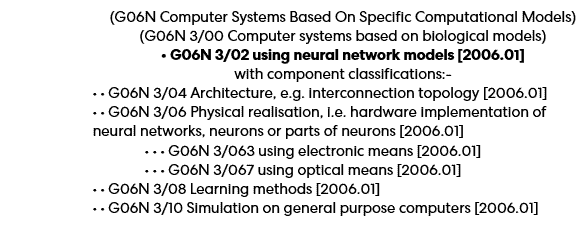 At the beginning or 2023 the hierarchy of IPC classifications relating to neural networks was revised and significantly expanded:
At the beginning or 2023 the hierarchy of IPC classifications relating to neural networks was revised and significantly expanded:
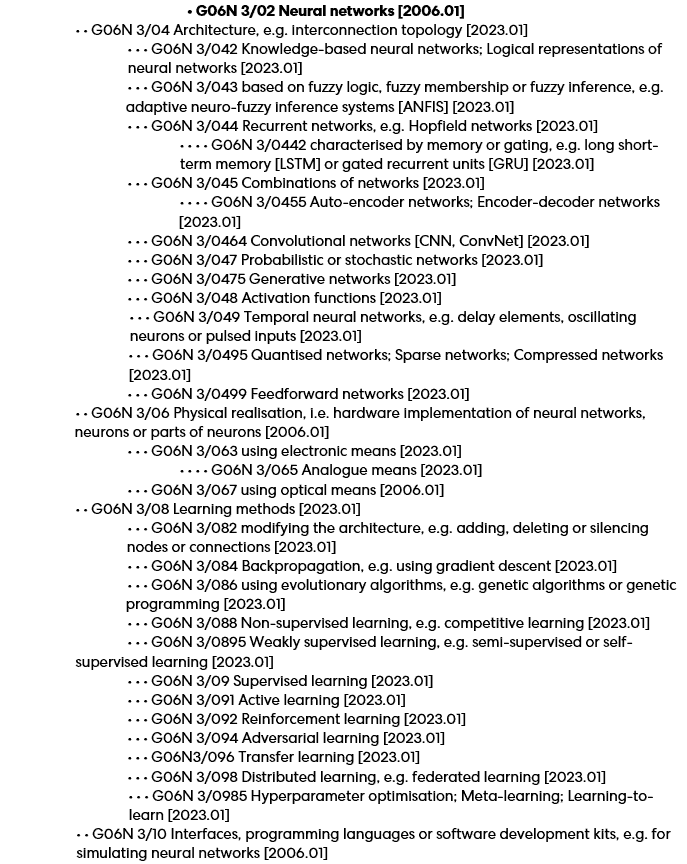
[iv] The basis of the query used for the new Espacenet database was:- “ipc=G06N3/02/low”
[v] The EP Bulletin Search database can be accessed via: https://data.epo.org/expert-services/index.html
The basis of the database query used was:- “(IPC=G06N000302* or IPC=G06N000304* or IPC=G06N000306* or IPC=G06N000308* or IPC=G06N000310*)”
[vi] At least for 2022 the numbers of applications deemed to be withdrawn and the numbers of applications refused so far will be understated: dates of “deemed withdrawal” and “refusal” are only retrospectively determined after expiry of any period allowed for rectification, challenge or appeal, or after a challenge, request for rectification or appeal has been dealt with.
[vii] For EP patents granted in 2021 (for all of which the EPO opposition term has expired) the opposed percentages of granted patents classified to general fields of technology were as follows: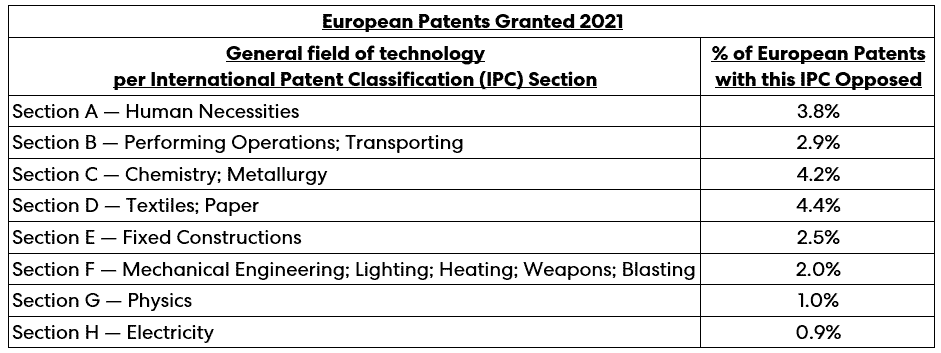
This is for general information only and does not constitute legal advice. Should you require advice on this or any other topic then please contact hlk@hlk-ip.com or your usual HLK advisor.
